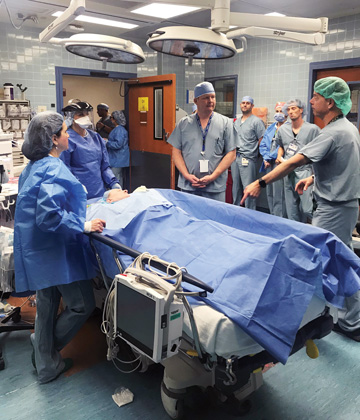Of course, this case is an outlier with lots of extenuating circumstances involved. After all, if there aren’t records of a prior history of airway issues, and the patient doesn’t disclose that information, what can you do? Obviously,
a bedside review is important, but Dr. Simon’s example illustrates one of the most crucial components of handling difficult airways: a solid airway history. “My first piece of advice to any anesthesia provider when it comes to
airway management is getting a thorough history with review of prior airway records,” says Michael Aziz, MD, a professor of anesthesiology and perioperative medicine at Oregon Health & Science University’s School of Medicine
in Portland. He adds that a bedside airway review can help, and providers must respect the clear indicators of potential intubation difficulties such as a patient who can’t open their mouth, but a history of airway issues is the best
predictor. And he would know. Throughout his 21 years as a physician, Dr. Aziz has handled several difficult airway cases — including a recent one involving an awake flexible scope intubation. “The patient received local anesthesia
plus a little sedation, and it was fairly well tolerated,” he says.
In addition to obtaining a proper history and performing a thorough assessment, here are some additional best practices anesthesia providers can use to ensure they are prepared for any difficult airway that comes their way:
• Use a difficult airway algorithm. “Make sure the American Society of Anesthesiologists’ (ASA) difficult airway algorithm is accessible and easy to read and follow,” says Dr. Simon. “Some facilities have it
in every OR, others have it laminated on the difficult airway cart.” It’s worth noting that the ASA made some changes to the algorithm in its “2022 American Society of Anesthesiologists Practice Guidelines for Management
of the Difficult Airway” (osmag.net/difficult2022).
• Keep up-to-date equipment. If your facility has a difficult airway cart (it should), make sure it is current with all the necessary equipment and fully stocked. And just what is the necessary equipment? “It’s important
for your providers to have access to alternative airway equipment such as an Eschmann Stylet or Bougie, intubating LMAs, a video laryngoscope, a fiber optic bronchoscope or any other advanced type of airway device,” says Dr. Simon.
The importance of having proper equipment at the ready is echoed by Dr. Aziz, who emphasizes the importance of video laryngoscopy technology in today’s ORs. “A lot of routine and difficult airway cases have transitioned to video laryngoscopy
because it improves patient outcomes,” he says, noting that there is a downside to this trend, too. “With the growth of video laryngoscopy, different airway techniques are being used less frequently.” That brings us to the
next best practice.
• Continual training. Having access to the latest advanced airway equipment is wasted if your staff isn’t properly and regularly trained on using everything at their disposal. “The human factors need to be optimized, and
staff must be prepared to use all airway tools,” says Dr. Aziz. “Regular simulation, drills and participation in airway courses are a must.”
Indeed, many outpatient anesthesia providers might not have the opportunity to put the new and emerging airway management techniques into practice, and that’s why Dr. Aziz is so bullish on regularly drilling staff, holding simulations and
attending workshops on the latest techniques. “Continuing education is huge for airway management, and there are national societies dedicated to this topic,” he says. “All anesthesia providers must learn to master the latest
techniques.” Dr. Aziz urges facilities leaders to make sure anesthesia providers are well-versed in supraglottic and mask techniques, direct and video laryngoscopy, flexible scope intubation for difficult airways and emergency surgical
airways. In addition to training staff on all the airway management devices and their uses, Drs. Aziz and Simon urge facility leaders to keep in mind the common mistakes providers often make in this area. “The most common mistake we
see is not soliciting help at the right time,” says Dr. Aziz. “Airway management requires providers to be one step ahead at all times and not having a backup plan is a common issue.” That means having more than one provider
available and understanding that a highly controlled situation can quickly morph into an uncontrolled difficult airway. It’s also imperative to limit your attempts at securing the airway. “The number of attempts should be kept
under two or three, and providers need to recognize when an approach isn’t working,” says Dr. Aziz.
Finally, because time is of the essence during difficult airway cases, Dr. Simon stresses the importance of making sure everyone involved in the case fully understands their surroundings as well as where to go and what to do in the event of a
problem. “Familiarize yourself with the facility where you are working, where they keep their difficult airway cart, where they keep their supplies, what type of equipment is on hand and what the providers’ skill level is with
that equipment,” he says.
.svg?sfvrsn=be606e78_3)

.svg?sfvrsn=56b2f850_5)